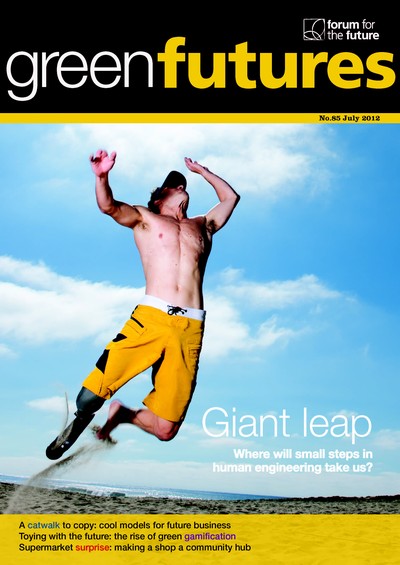
Green Futures is the leading magazine on environmental solutions and sustainable futures. Founded by Jonathon Porritt in 1996, it is published by Forum for the Future.
True story. Some years ago, a friend of mine was standing at the edge of a Scottish loch on a glistening blue spring morning.
The sun sparkled off the water, the hills rose soft and green around.
My friend stood alone, drinking it all in.
Suddenly a car drew up, and a man got out. He agreed it was a wonderful morning, strode briskly to the edge of the water, and lifted his video camera to his eye. He was just zooming in on a heron perched on a rock, when two children tumbled out of the car behind him and ran down to the water.
“Hey, you kids get back in there!”, the man shouted. “You can look at it when we get home!”
Never in human history has our relationship with nature been so mediated. Technology allows us to see more of the world than ever, to monitor and measure virtually every inch of it. And meanwhile, it seems, we spend less and less time away from the screen, experiencing it for ourselves. But that doesn’t mean we should cast our cameras and laptops into the nearest loch. On the contrary… In ‘Big Brother Gone Green’ [p20], we track some of the imaginative ways in which people are using the latest sensing and monitoring technology to guard endangered species, pinpoint pollution and even help rainforest tribes defend their birthright.
Reassuringly, perhaps, some things are still better unmediated. Brainstorming, for example. In ‘Connect Force’ [p30], we discover how, when it comes to dreaming up bright ideas to tackle big problems, you can’t beat a bunch of warm bodies in a room.
Such a phrase might also neatly describe one of tomorrow’s common consumer experiences. We’ve become so used to a world where big brands supply and we buy, that the future is sure to surprise us. Sally Uren’s ‘Shopping for Tomorrow’ [p26] unveils a range of possible scenarios that could see today’s shoppers become tomorrow’s swappers – or leasers, or even producers, too. It doesn’t mean that the big brands are shuffling off to a dinosaur graveyard. Far from it. They have a huge role to play in the shift to something approaching sustainable consumption. But they will have to adapt to some bracing new realities – or wither in the fire of smart competition.
Smart upstarts are at the heart of some extraordinary innovations in materials, too [‘Material World’, p16] – promising a future where murals clean the air; where buildings heal themselves; and where roofs and windows change with the weather to warm us up or cool us down. Our homes might even respond to our presence – our movements, our heartbeat, our scent…
Meanwhile, it’s easy to forget that for upwards of a billion people, the height of home lighting technology is still a dirty wick suspended in a saucer of highly inflammable kerosene. Which makes this issue’s profile [‘The man who put the sun in a box’, p32] all the more heartening. Andrew Tanswell’s business, ToughStuff, has now sold around 150,000 simple solar lanterns, many times brighter than their kerosene equivalent, and infinitely safer, too – and all without a penny in subsidy. If you’re after an example of genuinely sustainable consumption, you can’t get much better than that.